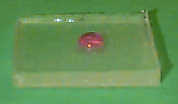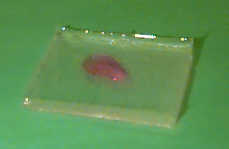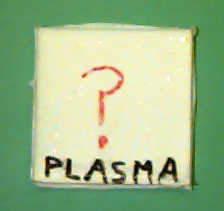

Experiment 4 - Surface Treatment of PDMS
Cured PDMS has a very low surface energy. That is, it is difficult for chemical
species to interact with the surface, and adhesion is poor. Changing the surface
characteristics of the polymer to give it a higher surface energy will enhance
the adhesion characteristics of the polymer.
Materials
- Cured Sylgard Elastomer 184 polydimethylsiloxane, obtained from Ellsworth Adhesive System,
with a smooth surface (such as the cured slab fabricated in Experiment
2; the non - diffracting surface should be sufficiently smooth)
- Marker, such as a Sharpie
- Hand - held Tesla coil used to test for leaks
Procedures and Explorations
- Place the cured PDMS slab on a level surface with the smooth side up. Place
a drop of water on the surface. The drop will "bead," i.e., the
water in the drop will be attracted more to itself than to the surface of
the PDMS and it will attempt to form a spherical shape. Because water is not
attracted to the PDMS, the surface is referred to as being hydrophobic ("water-fearing").
Examples of items containing hydrophobic surfaces include waxed paper and
waxed cars.

Figure 1. Water beading on a hydrophobic PDMS surface. (Dye has
been added to the water to provide contrast; it is not necessary for this experiment.)
- Dry the slab and attempt to write on it with a marker. Most marker inks
are also not attracted to the PDMS and will bead up on the surface.

Figure 2. Marker ink beading on a hydrophopic PDMS surface. (Titanium
oxide has been mixed into the PDMS to provide contrast; it is not necessary
for this experiment)
- The PDMS surface may be oxidized with the discharge from a Tesla coil. This
corona discharge electrically breaks down chemicals comprising the air. Some
of the chemical species produced by this process can react with the PDMS surface
to convert it to a less hydrophobic surface. High energy electrical discharges
like this are used to modify many other surfaces. Warning: Tesla coils are
electrical devices with very high voltages; please follow recommended usage
instructions. Moving the tip of the coil back and forth ~3 cm above the surface
for ~30 seconds appears to provide sufficient surface oxidation time. Shut
off the Tesla coil when it is not being used.

Figure 3. Oxidizing the surface of PDMS with a Tesla coil.
- Place a drop of water on the oxidized PDMS surface. The drop will "wet"
the surface, i.e., the water in the drop will be attracted more to the surface
of the PDMS than to itself and attempt to flatten. Because water is attracted
to the PDMS, the surface is referred to as being hydrophilic ("water-loving").

Figure 4. Water wetting a hydrophilic PDMS surface. (Dye has been
added to the water to provide contrast; it is not necessary for this experiment.)
- Dry the slab (you will probably find it harder to dry) and attempt to write
on it with a marker. Most marker inks are now attracted to the surface (as
they are to paper, which typically is hydrophilic) and will form higher-quality
marker lines.

Figure 5. Marker ink on a hydrophilic PDMS surface. (Titanium
oxide has been mixed into the PDMS to provide contrast; it is not necessary
for this experiment)
Return to the PDMS Main Page
Experiment 1 - The "Intial"
Stamp
Experiment 2 - A Flexible Diffraction
Grating
Experiment 3 - Bouncing PDMS Balls
Exploring
the Nanoworld |
MRSEC Nanostructured Interfaces
Copyright © 2006 The Board of Regents of the University
of Wisconsin System.






